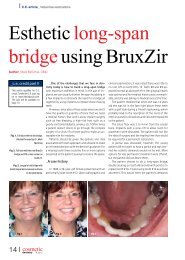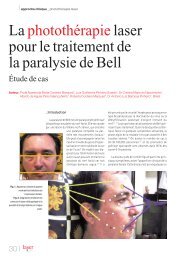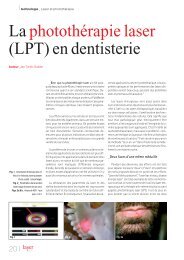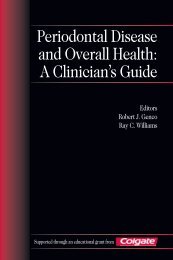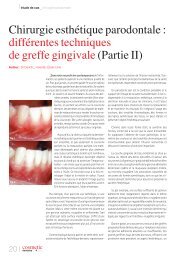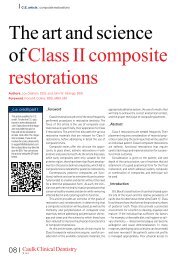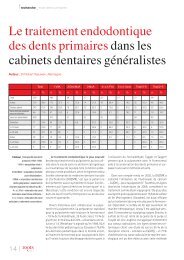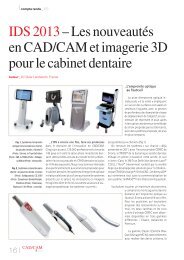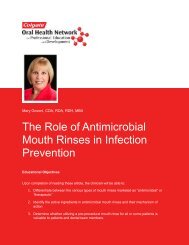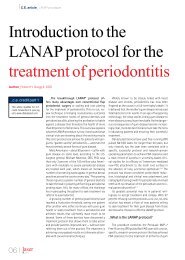Periodontal Disease and Overall Health: A Clinician's Guide
Periodontal Disease and Overall Health: A Clinician's Guide
Periodontal Disease and Overall Health: A Clinician's Guide
Create successful ePaper yourself
Turn your PDF publications into a flip-book with our unique Google optimized e-Paper software.
CHAPTER 3 Infection <strong>and</strong> Inflammation 25directed at mechanisms of inflammationresolution that may be used in treating in -flammatory diseases.PART I: INFLAMMATIONAT THE GINGIVAL LEVEL<strong>Periodontal</strong> disease is an inflammatorydisorder of the gingiva initiated by bacteriathat leads to the destruction of the supportingtissues of the teeth in a susceptible host. Bacteriain the oral cavity colonize the teeth, thegingival sulcus, <strong>and</strong> eventually the perio -dontal pocket, forming an organized biofilm.Depending upon the stage of maturation, thebiofilm may consist of several hundred differentbacterial species, many of which haveyet to be identified. 6 Some of these speciesare associated with health, whereas othersare associated with pathology. 7 However,which organisms actually initiate disease remainsunknown.Bacterial ComponentsThe formation of organized biofilmsenhances the ability of bacteria to survive.Bacteria have also evolved a variety of virulencefactors to further enhance their survival,such as toxins, proteases, <strong>and</strong> glyco -sidases. Virulence factors are presumablyintended to hide the bacteria from host detectionas well as to provide essential moleculesfor nourishment. Conversely, the hosthas evolved mechanisms for detection ofbacteria through the recognition of structuralcomponents of the bacterial surface, such aslipopolysaccharide (LPS), peptidoglycan(PGN), <strong>and</strong> other cell surface componentssuch as fimbriae that perform essential physiologicfunctions for the bacteria. Variationsof these bacterial components may be seenbetween various species, or even betweendifferent strains of the same species. Despitetheir structural heterogeneity, most of thesemolecules have conserved motifs known aspathogen-associated molecular patterns(PAMPs) that are recognized by host cellreceptors called pattern recognition receptors(PRRs). These highly conserved innate immunereceptors evolved for detection of invadingbacteria. Binding of PAMPs by PRRsactivates specific signaling pathways in hostcells that are important for the initiation of aninflammatory response. Although this responseis intended to eliminate the microbialchallenge, the inflammatory mediators thatare secreted may lead to further tissue damageif bacterial clearance is not achieved.Today, the most studied bacterial factorsinclude LPS, PGN, lipoteichoic acids (LTAs),fimbriae, proteases, heat-shock proteins(HSPs), formyl-methionyl-leucyl-phenyl -alanine (fMLP) <strong>and</strong> toxins. Host PRRs includethe Toll-like receptors (TLRs) <strong>and</strong> theG-protein-coupled receptors (GPCRs). Table1 presents a summary of the results by actionsof various bacterial factors after inter -action with specific host cells. 8Bacteria <strong>and</strong> GI EquilibriumThe oral cavity, as part of the gastro -intestinal tract, is naturally colonized by awide variety of bacteria. This is a physiologicsituation that does not always result inpathology. The tooth-gingival interface is thesite of a variety of natural, innate host defensemechanisms, including the regular sheddingof epithelial cells, the washing effect of thesaliva <strong>and</strong> the gingival crevicular fluid (GCF),<strong>and</strong> most importantly, the phagocytic actionof neutrophils that migrate continuouslythrough the junctional epithelium into thegingival sulcus. However, if this equilibriumis disturbed, pathogenic bacteria may overgrow,initiating the pathogenesis of gingivitis<strong>and</strong> possibly periodontitis. Current under -st<strong>and</strong>ing of the steps leading to overgrowthof pathogens includes periodontal bacteriaattaching to epithelial cells using their fimbriae<strong>and</strong> PRR recognition of PAMPs, inducingepithelial cell secretion of pro-inflammatorycytokines (TNF-, IL-1, IL-6)<strong>and</strong> the chemokine IL-8 in the connective



